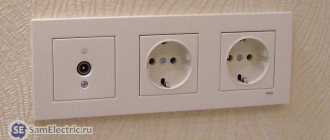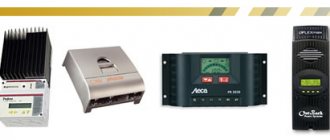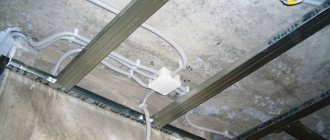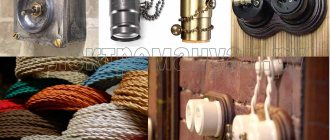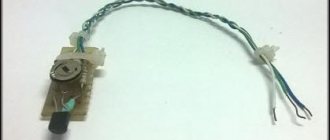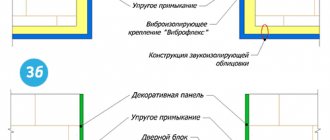G-shaped
A less popular type of slats. The application is no different from the C-shaped one.
- The dimensions of the slats correspond to the GOS standard. The standards are as follows:
- The Ω-shaped rail, which is called TN-35, can also be of different sizes:
- The length of the slats can vary, most often it depends on the manufacturers. The length can start from 7 cm to 200 cm. A similar rail can be used to install a panel from 4 to 96 modules.
DIN rails are divided into two types according to the casting method. Slats made of continuous casting. Installing such a rail is a little labor-intensive, unlike the second type, but such a rail can withstand more load and can withstand many machine mounts in the cabinet.
The second type of slats provides holes that greatly simplify the method of attaching the slats to the surface. It is enough to screw the screw into the hole; the distance between the holes is 1-1.5 cm. This way you can securely fix it to the surface. But due to the presence of holes, the rail becomes less durable.
DIN rails are made from aluminum and stainless steel. To install electrical appliances, stainless steel slats are used.
For certain cases, slats of improved strength and depth are available for sale. Their use depends on the location and case of work.
There are various brands of slats on the shelves of hardware stores. The most popular, distinguished by their quality and price category, are the following manufacturers: ABB, IEK and DKS. You can find products that are suitable in quality and price.
Load characteristic selection
This parameter is important and should be planned during installation. Aluminum analogues have the following features:
- With a thickness of 1 mm, it is possible to install automatic protection modules, RCDs, and power supplies. During the work, the slats are cut into separate blocks.
- With a thickness of 1.1 mm - designed for installation of individual modules in rows.
- 1.4 mm slats support modules regardless of their weight.
- Analogs made of 1 mm steel and 1.5 mm aluminum are resistant to different loads and can be used in any conditions.
Din Rail Superiority
The din rail greatly simplifies the process of fastening electrical appliances, in turn, this allows you to equip switchboard rooms with more modern equipment.
- Modules for DIN rails are the same size, thereby greatly simplifying the mounting process. You can use one mounting device for different modules.
- Previously, panels with two plugs were used and attached; at present, such electrical panels are considered obsolete. Also, the methods of fastening them, fastening with nails, nuts, screws and other things are also considered obsolete.
Modern panels are much more compact, equipped with additional switches, zero busbars, protective busbars, and a working busbar, and additional equipment.
Assembling this structure will not cause you any difficulties. Using a DIN rail will also simplify the installation process. The modern shield fits harmoniously into the interior without attracting unnecessary attention.
Types of din rails
According to GOST 60715, mounting rails are available in three types:
- TN type (TN 15, TN 35, TN 75);
- C type (C 20, C30, C40, C50);
- G type (G 32).
You can read in detail about the types of slats in GOST, it doesn’t matter. For practice, it is important that you will be dealing with TN type slats, the profile of which is visible in the pictures. For electrical circuits of apartments and houses, a DIN rail with a width of 35 mm (TN 35) is used, with a shelf height of 7.5 mm. The types of slats differ in profile thickness (from 1 to 1.5 mm) and the diameters of the installation holes (4 mm, 5 mm), which are clearly visible in the figures.
Tires on rack
A bus on a din rail is necessary to combine the ground wire and the neutral wire. Can be used at voltages up to 400V.
The bus is a plastic structure equipped with a mechanism for mounting on a DIN rail. The design contains from 2 to 4 bronze bars, between which there is a transparent material. The design is protected from third-party influences by a transparent panel.
What is DIN rail
DIN rail is an imported invention, and that is why it is often called DIN rail. The abbreviation DIN stands for the German standard, DIN 43880-1988 “Built-in electrical appliances. Overall and corresponding installation dimensions”, where this rail was first standardized. In Russia, this product is standardized in GOST R IEC 60715-2003 and is often called a mounting rail. Expanded name: mounting rail for installation (fastening) of electrical devices in low-voltage distribution and control devices for electrical networks (electrical circuits).
DIN rail mount
This type of slats has specific edges turned outward. They serve as a place for fastening. Also, thanks to them, the structure can move without problems along the entire length of the rail.
If there is no need to move the structure, stoppers are installed along the edges of the fixed apparatus to prevent the structure from moving. Reliably fixing it in one position.
- In rare cases, small holes are made on the shield cover to facilitate fastening.
- Some devices have already installed fasteners to fix it on the rail.
- You must press the latch until it clicks, this way you secure the structure.
- Removing such a latch is not difficult; just use a flat screwdriver to bend the edge of the latch and the structure can be removed.
If you are installing electrical appliances on a DIN rail for the first time, you can turn to online resources and video clips with a detailed description. If you study carefully, installation will not take much time.
How to install slats in an apartment (country) electrical panel
The slats are installed on the mounting bolts at the installation site. The rail is attached in two places along the edges. It is not recommended to allow the edges of the slats to droop, so the slats must be cut to size before installation.
In difficult places where direct installation of modular equipment will be difficult, special holders for DIN rails are used, which allow you to rotate it at a certain angle.
DIN rail selection
When choosing a rack, pay attention to the manufacturer. Choose from ABB, IEK and DKS. These manufacturers produce high-quality slats at an affordable price.
- DIN rail profile. The Ω-shaped rail, which is called TN-35, is suitable for installing various types of electrical panels. The design is easy to assemble.
- Length of the slats. Consider the size of the rail you will use to attach the modules. The rail must be taken according to the size of the electrical cabinet.
Features of application
DIN rail is a foreign invention that takes its name from the German standard designated DIN 43880-1988.
In our country, their use is regulated by GOST R IEC 60715-2003. These products are sometimes called mounting rail. The full name looks like this: “mounting rail for fixing protective devices in low-voltage distribution and control equipment for electrical networks.” In accordance with this definition, its scope extends to the following cases:
- the need to install electric meters and other types of measuring equipment in the distribution cabinet;
- the need to place protective equipment there (RCDs, automatic circuit breakers, voltage relays, etc.);
- If desired, install special connecting fittings into the cabinet.
Types of DIN rails
The decisive factor determining the capacity of such a rail is the width of the machine module or similar protective equipment installed on its base.
When assessing the width of the machines, they are based on the specific number of protective devices used in the panel, which can have a single-pole or multi-pole design. The second option concerns three-phase networks. In general, its use is limited to this particular set of functions, but in certain situations other directions for using the DIN rail are possible.
Dimensions and installation method
In domestic conditions, standard strips with a profile width of 35 mm (TN 35), having a shelf height of about 7.5 mm, are traditionally used. Different versions of the product may differ in the declared thickness of the profile (1-1.5 mm) and the diameter of the holes filled during perforation (4 or 5 mm). To attach them to the distribution board guides, you will need bolts of the appropriate size.
The installation product is fixed at the two extreme points of the strip in such a way that there are no parts protruding beyond the cut of the guides. That is, the length of the workpiece is selected exactly to size, for which the side excesses are cut off in advance.
In hard-to-reach places with difficult working conditions with modular equipment, it is possible to install holders for DIN rails of a special design. Such guides allow you to rotate them to a convenient angle if desired.
Strength
As previously mentioned, slats are made from various materials. Each of them has a load limit. When purchasing a slats, consider this factor. For heavy loads, stainless steel slats are suitable.
Aluminum slats can withstand different loads. The load is classified depending on the thickness of the slats.
- The thickness of the 1mm rail is suitable for fastening a single device that is light in weight.
- The 1.1mm rail thickness is intended for several modules.
- The thickness of the slats is 1.4mm-1.5mm and is particularly durable. Can be used for fastening massive devices, switches and high-power devices.
When choosing Din rails, carefully consider the choice of manufacturer, quality of material, strength and scope of application.
Kinds
They are produced in different sizes and shapes. It is clear that you need to install a short rail in a small shield. And the long one is sometimes even called DIN rail. The rail is fastened with screws or bolts, for which the manufacturer has already drilled a series of oblong holes on it. They are also produced without holes, which, in general, gives a little more hardness. During installation, you will then need to accurately drill where the rail will be attached to the base. Material - aluminum or steel, galvanized or stainless steel
Actually, reliability is important, and not physical lightness, so that the rail firmly holds the modules installed on it, because this is most often very important for powering the apartment, and for its safety, and for the equipment. What needs to be installed once, but with 100% confidence in the results
The manufacturer plays a role. Actually, its production culture. This can always be seen by the absence of burrs, strictly maintained linearity of shape, as well as the size, thickness and quality of the metal. There are several popular manufacturers: ABB, IEK, DKS. But many well-known companies are engaged in the production of electrical accessories, so it is better to be guided by considerations of a fundamental nature when choosing.
Three profiles are available.
Ω-shaped (omega). We use it most often. Machines and metering devices are attached to it.
Omega DIN rail
C-shaped. Hardware clamps and terminal blocks are placed on them.
DIN rail C
G-shaped profile. Almost the same as a type C rail, only for specific clamps.
DIN rail type G
Photo DIN rails
Installing a circuit breaker is easy
Circuit breaker installation can be divided into three parts:
- DIN rail fastening;
- Installation of a circuit breaker;
- Connecting the circuit breaker.
DIN rail mounting
In a new electrical panel or electrical box, the DIN rail is attached to ready-made places using self-tapping screws or bolts.
To install a DIN rail in an old floor panel, you need:
- Drill two holes in the metal platform of the shield;
- Cut threads into them;
- Secure the DIN rail with two bolts.
In the new floor panels, special perforated racks are already installed for fastening DIN rails, and fastening the DIN rails is not difficult.
Circuit breaker installation
After installing the DIN rail, we proceed to installing the circuit breaker.
- Prepare the circuit breaker and a long screwdriver;
- Pull the latches down and slide the circuit breaker onto the DIN rail;
- Release the latch. It should catch on the DIN rail.
A three-phase circuit breaker is installed in a similar way.
Circuit breaker connection
- To connect the circuit breaker, unscrew the screws of the upper and lower terminals;
- Insert pre-protected wires into the clamps;
- Tighten the clamps firmly, but not too enthusiastically.
The household series of switching equipment has another name - modular. The reason for this is that all circuit breakers, switches, and RCDs are assembled from modules of the same width. Their overall dimensions are approximately the same.
An important property of the modular series equipment is that its mounting is unified. Let's remember how old circuit breakers were attached to the surface. To do this, it was necessary to drill holes, sometimes even cut threads into them. And also use fasteners: screws, nuts, washers. Not only is this inconvenient, but it is also unsafe. In an electrical panel, part of which is energized, replacing the circuit breaker is carried out with a certain degree of risk. A dropped screw can short-circuit a phase to the housing and cause a short circuit. And both an amateur and a professional electrician can drop it.
No screws are required to fasten electrical equipment of the modular series. All of them are installed on a standard metal strip. It's called a din rail, let's figure out what it is.
The abbreviation DIN comes from the abbreviation of the name of the German Institute for Standardization, Deutsches Institut fur Normund. Strictly speaking, this abbreviation is used not only to designate rails, it is used in other areas to mark standard connectors, fastener parameters, and so on.
Why is electrical knowledge necessary?
Information about electrical devices known from school physics lessons is not enough for practical use.
The average consumer more often encounters circuit breakers, since they are the ones that trip due to network overloads. It is not enough to simply return the lever to its usual position; you must definitely understand the reasons for the shutdown, otherwise the situation may repeat itself in the near future.
Do you need to be able to change the automation yourself? We recommend that you first study the theory, and at the first shutdown, practice.
We offer:
- Install circuit breakers, circuit breakers, RCDs, VDTs, RCBOs, contactors and automation in existing switchboards
- Repair of electrical panels , troubleshooting, technical audit, audit and condition check of existing panels and assemblies
- Turnkey assembly of electrical panels according to the existing design with high quality and full compliance with the single-line diagram
- Calculation of electrical loads and a single-line diagram for assembling a switchboard with justification for the ratings and types of protection devices
- Power supply project for a store, office, cottage, restaurant, canteen, cafe, production - “turnkey” with protection from technical supervision and expert examination
- As-built documentation for the existing electrical panel and single-line diagram “in fact”
- Preparation of the electrical panel for delivery to RosTechNadzor and removal of comments, protection during acceptance and inspection
Contact us, you will receive professional advice , assistance in resolving difficult and controversial issues, as well as electrical installation work of the highest quality .
For CONSULTATION on the installation of circuit breakers and the cost of installation work, send a request using the form below, and we will contact you within a day. Thank you!
{SOURCE}
Selecting an electromechanical device
Taking into account the load parameters and cable characteristics, you can select a device for installation in an electrical panel. All necessary information about the electromechanical device is located on its front panel.
The ability to decipher the switch markings will help you make the right choice.
Voltage, frequency and rated current
In the next line you can find information about two important characteristics - voltage and frequency. The most common “format” is 220/400V 50Hz. This means that you can connect one or three phases at a frequency of 50Hz.
If we take all design types, then the correspondence of poles and voltage will be as follows:
- 1-pole – 220 V, (1 wire – phase);
- 2-pole – 220 V (2 wires – phase/neutral);
- 3-pole – 380 V (3 wires – phases);
- 4-pole – 380 V (3 phases/1 zero).
The rated current value limits the use of certain types of cables - and be sure to take this into account when choosing automation. Therefore, when buying a switch for an electrical panel, check what types of wires are involved in constructing the overall circuit.
The preliminary calculation of the circuit breaker rating is based on data on the total power of consumers, the presence of starting current of some electrical appliances, current strength and the estimated demand coefficient.
Under no circumstances should you rely on the maximum voltage in the network, otherwise the following may happen.
Let's assume that buying new household appliances leads to overloading and constant knocking out of the machine. You will want to increase its power and replace it with a new one that has a higher current rating.
As a result, when several powerful devices are connected to the network, the machine will not work, but the wires will overheat, resulting in a short circuit (the insulation will melt and a fire will occur).
The circuit must be built in such a way that the weakest link is the circuit breaker (not the wires), which is designed to protect against overload.
Is VTX important?
The letter designation of the time-current characteristic precedes the digital marking that determines the rated current.
To understand what the essence of technical characteristics is, let’s look at the formula:
k=l/ln , where
- l – current in the network;
- ln – rated current value;
- k – multiplicity.
The category depends on the multiplicity:
- B– 3
The operating speed of the machine depends entirely on the multiplicity: the larger it is, the faster the shutdown will occur. For domestic use, the listed categories are used, but in addition to them you can find circuit breakers with BTX categories G, K, L, Z.
Circuit breaker B16 at a current of 150 A operates instantly, while D16 only after heating the plate, after several minutes. The most common category C is used in everyday life and in production, in networks with medium and low starting currents. Category B refers to high-speed ones and is involved in old network schemes.
Item Description
So, din rail is a generalized name for a metal profile that is used in electrical engineering. This rail can be galvanized steel or simply aluminum.
It all depends on parameters such as:
- weight;
- strength;
- the strength of the current passing through the ground terminals.
The lath can be either continuous or with a regular perforation step. In addition, there are options with preliminary notching, which greatly facilitates cutting to a certain length.
The very origin of the abbreviation “din” is very simple - it is an abbreviation for the German Institute for Standardization: Deutsches Institut fur Normund. To be fair, it is worth noting that this abbreviation applies not only to rails, but also to other products - connectors, fasteners, etc.
About the installation method
Let us briefly consider the DIN rail mounting method. In cross-section, it has protrusions along the edges. They are designed to hold the device, which is installed on the rail. But at the same time it can be moved relatively freely along it. If such “freedom of action” is not welcomed, then it can be completely eliminated. To do this, you simply need to install special locking elements on the sides of the device, which are also designed for installation on DIN rails.
It is worth noting that in panels that are used for mounting modular equipment, fixation is often performed by creating external holes in the cover, taking into account the actual number of switching equipment. That is why the windows for the outer part of the equipment do not open completely. Some of them are usually covered with curtains, which can be easily removed if necessary. If it so happens that there is less equipment in the panel than could be installed, then all the free spaces that remain are closed with special plugs.
It is worth adding that all modular machines, circuit breakers and RCDs are equipped with special latches. They are designed to hold the element on the DIN rail. To install, the upper groove of the device is fixed on one of its lower edges. In this case, the lower edge of the device is pressed against the rail with slight force until an obvious click is heard.
If the element needs to be removed, you will need a flat-head screwdriver. With its help, you need to carefully move the latch down and remove the device from the groove. It is worth adding that there are elements of equipment in which the latch is fixed in the open position.
What can be installed on a DIN rail?
In addition to protection devices, other elements that are standardized for it can be installed on the DIN rail. These can be electricity meters, relays, automation devices, terminals, signaling and control devices, and zero buses. Many elements of electrical circuits have double fastening points. Due to this, they can be installed both on a DIN rail and on a regular classic surface.
Briefly about the types
It would be wrong if we did not mention that DIN rails come in different types. The most common type is the TN-35-7.5 rail. How to understand these numbers? Very simply, the rail is thirty-five millimeters wide and seven and a half high. There is also another modification - with a height of fifteen millimeters, that is, the TN-35-15 DIN rail. This option is quite often used in wall-mounted and floor-mounted panels. It is worth noting that such slats are also called Ω-type slats. It’s easy to understand where this name comes from if you carefully examine this element in profile.
If we talk about the length, then according to the standard it is two meters. But this is not always convenient, so in most stores DIN rails are sold in pieces of twenty centimeters.

